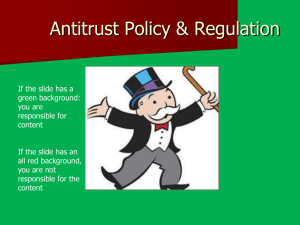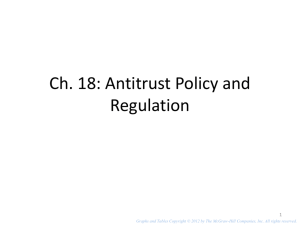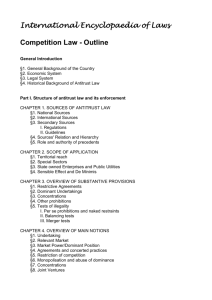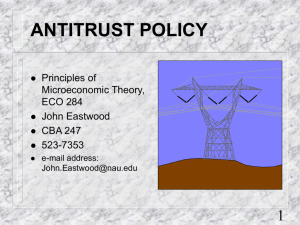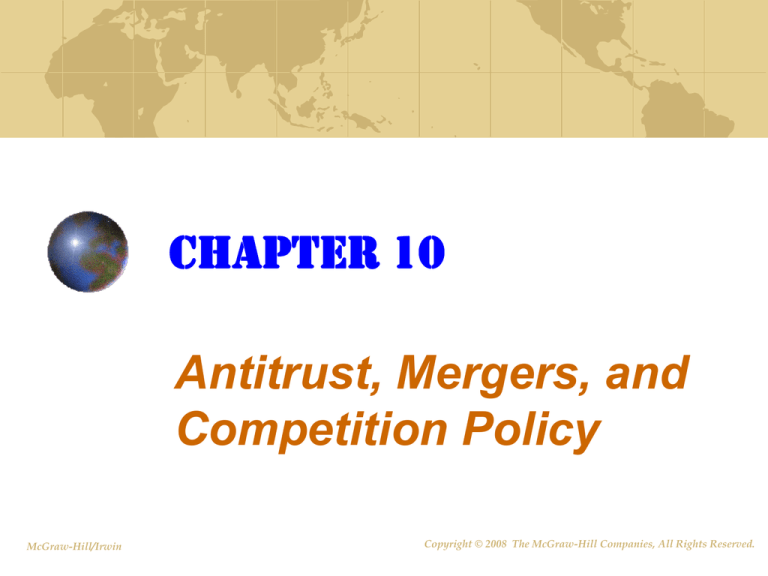
Chapter 10
Antitrust, Mergers, and
Competition Policy
McGraw-Hill/Irwin
Copyright © 2008 The McGraw-Hill Companies, All Rights Reserved.
Ch. 10: Key Learning Objectives
Understanding the dilemmas corporate power
presents in a democratic society
Knowing the objectives of antitrust and competition
laws
Recognizing the key issues in contemporary antitrust
policy
Analyzing the reasons for mergers and acquisitions,
and how have they affected the relationship between
business and its stakeholders
Assessing how competition policies compare around
the world, and what impact globalization has had on
antitrust enforcement
10 - 2
The Dilemma of Corporate Power
Corporate power
The capability of corporations to influence
government, the economy, and society, based on
their organizational resources
Power can be a function of size and world’s largest
corporations are very big
Figure 10.1 shows 10 largest global corporations
10 - 3
Figure 10.1
The 10 Largest Global
Corporations, 2005-2006
10 - 4
The Dilemma of Corporate Power
Economic power is evident when compare largest
corporations’ annual sales revenue with countries
whose GPD (gross domestic product) is at same
level
Figure 10-2 shows this comparison
The dilemma of corporate power concerns how
business uses its influence, not whether it should
have power in the first place
10 - 5
Figure 10.2
Comparison of Annual Sales with GDP for
Selected Transnational Companies and
Nations, 2004
10 - 6
Antitrust Laws
Antitrust
Laws that prohibit unfair, anti-competitive practices by
business
Term derives from trust, the old-fashioned word for
groups of companies that joined together to divide up
markets and limit competition
New term for trust is cartel
The term antitrust law is used in the U.S., most other
countries use the term competition law
10 - 7
Objectives of Antitrust and Competition Laws
The protection and preservation of competition
To protect the consumer’s welfare by prohibiting
deceptive and unfair business practices
To protect small, independent business firms from
the economic pressures exerted by big business
competition
To preserve the values and customs of small-town
America
10 - 8
The Sherman Act
Prohibits contracts, combinations, or conspiracies
that restrain trade and commerce
Prohibits monopolies and all attempts to monopolize
trade and commerce
Provides for enforcement by the Justice Department,
and authorizes penalties for violations
10 - 9
The Clayton Act
Prohibits price discrimination by sellers
Forbids requiring someone to buy an unwanted
product or service in order to get another one they
want
Prohibits companies from merging if competition is
lessened or a monopoly is created
Outlaws interlocking directorates in large competing
corporations
10 - 10
The Federal Trade Commission Act
Created the Federal Trade Commission to help
enforce antitrust laws
Prohibits all unfair methods of competition
Gives more protection to consumers by forbidding
unfair business practices
10 - 11
The Antitrust Improvements Act
Requires large corporations to notify the Justice
Department and the Federal Trade Commission
about impending mergers and acquisitions
Expands the Justice Department’s antitrust
investigatory powers
Authorizes the attorneys general of all 50 states to
bring suits against companies that fix prices and to
recover damages for consumers
10 - 12
Antitrust Law Exemptions
Some organizations are not covered
For example, Major League Baseball
Others not covered
Labor unions
Agricultural cooperatives
Insurance companies (regulated by State law)
Business transactions related to national defense
10 - 13
Figure Antitrust Enforcement at the Federal Level
10.3
10 - 14
Key Antitrust Issues - Monopoly
Does domination of an industry or a market by one or
a few large corporations necessarily violate antitrust
laws?
Should the biggest firms in each industry be broken
up?
The courts have found that monopoly per se is not
illegal
If a company dominates the market because it offers a
superior product or service, has invented something unique,
or even because it is just lucky, that is not against the law
If, however, a firm uses its market dominance to restrain
commerce, compete unfairly, or hurt consumers, then it may
be found guilty of violating antitrust laws
10 - 15
Key Antitrust Issues - Innovation
In early days of antitrust law, regulators promoted
competition in order to provide consumer choice and
keep prices down
Today, in the fast-paced economy, regulators have
increasingly promoted competition to foster
technological innovation
Quote from Federal Trade Commission Chairman:
“Innovation is more and more the central arena in which
competition plays out. [It] is the hot issue for the foreseeable
future.”
10 - 16
Key Antitrust Issues – High Technology Businesses
Economy has changed from when antitrust laws were
crafted in the late 19th and early 20th century
We are now in the information age, where primary
currency is intellectual property
Some argue that the basic principles of antitrust law
are not applicable today
Monopolies in high-tech businesses are inherently unstable
with low barriers to entry and dynamic technological change
constantly changing basis of competition
Courts are struggling to resolve ways antitrust laws apply to
high tech industries
10 - 17
Corporate Mergers
Corporate merger
A combination of one company with another
Vertical mergers
Occur when the combining companies are at different stages of
production in the same general line of business
Horizontal mergers
Occur when the combining companies are at the same stage or
level of production or sales
Conglomerate merger
Occurs when firms that are in totally unrelated lines of business
are combined
10 - 18
Figure 10.4
Three Different Types of Corporate
Mergers
10 - 19
Forces Driving Mergers in the 1990s and 2000s
Technological change
Major companies jockeyed for position in rapidly evolving
technologies
Changes in regulatory environment
Examples include telecommunications deregulation and
changes in health care industry laws
Globalization
Companies found they needed to be big to operate on the
global stage
Stock price appreciation
Bull market in late 1990s gave some companies the means
to purchase others
10 - 20
Figure 10.5
Value of mergers and acquisitions,
1990 – 2005
10 - 21
Consequences of Corporate Mergers
What stakeholders will be helped and what
stakeholders will be hurt by wave of corporate
mergers?
Mergers bring benefits to the firm, like economies of
scale and access to new technologies
Sometimes, however, undermine responsibility to
some stakeholder groups
Examples include employees losing their jobs and
communities negatively impacted by companies moving out
Shareholders can lose if the merger is not well
thought out or acquisition was overpriced
10 - 22
Comparative Competition Policies
Europe has lagged behind U.S. in antitrust regulation,
but is catching up
EU today has complete set of competition policies,
however enforcement emphasis is different
Attention paid to market domination by former state-run
enterprises
Concern with price discrimination across borders
Strong inclination to protect small business
Developing nations have moved to adopt their own
competition policies
10 - 23
Globalization and Competition Policy
Rapid globalization of business has created challenges for
antitrust enforcement:
Should a government permit mergers, or joint ventures, even
if they reduce competition, if they enhance the ability of
domestic businesses to compete internationally?
Should a country government move to break up monopolies,
if the global marketplace for the products offered is highly
competitive?
Should regulators try to enforce antitrust laws against foreign
companies if they operate subsidiaries within their borders?
What steps can governments take to create a level playing
field, so that corporations operate under a common set of
antitrust rules and regulations wherever they do business?
10 - 24
Antitrust Enforcement and National
Competitiveness
Regulators have dilemma when goal of competitive
market conflicts with goal of strong economy, relative to
other countries
Since mid-1980s U.S. has permitted cooperative activities
among firms where appropriate to enhance their
competitiveness in the global economy
The 1984 National Cooperative Research Act (NCRA)
sought to balance cooperative R&D with competition by
instructing the courts to use a “rule of reason”
European regulators have similarly permitted joint R&D
aimed at improving the competitiveness of their industries
Regulators have also loosened rules governing joint
production agreements to permit economies of scale
10 - 25
Enforcing Antitrust Laws against Foreign Firms
In recent years, regulators have been more willing to
address possible violations of antitrust law by foreign
companies
Example - requiring merged Swiss drug companies Sandoz
and Ciba-Geigy to divest product lines in the U.S. to avoid
being a monopoly
European regulators have become more active in
enforcement against U.S. companies
Example – European court in 2005 upheld EU’s veto of
General Electric’s acquiring of Honeywell
10 - 26
Harmonization
Harmonization is process being used to coordinate laws and
enforcement of competition policies across countries
Several bilateral treaties are in place
OECD has worked to coordinate antitrust enforcement
EU and U.S. now jointly review global mergers
EU also coordinating more closely with Japan Fair Trade
Commission
Despite these efforts, lack of common standards creates a
problem for cross-border mergers
Brookings Institution report has called for multi-country effort to
harmonize competition policies
10 - 27




